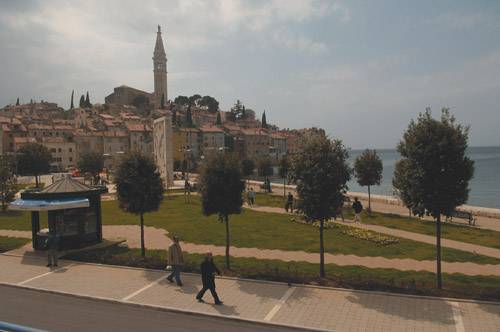The Rules
| While you're out photographing, it helps to keep in mind a mental checklist of the "rules" of photography that will improve virtually every photo you shoot. Like most rules, sometimes these should be broken, but having them in your photographic utility belt makes for better pictures. Look at What You're ShootingIt may seem obvious, but one of the most common reasons for poor compositionis that people often don't take the time to look. Before you press the shutter release, take a few seconds to look at the picture you're about to capture. There are occasions when it's better to rush and get something than to take your time and miss the shot, but those are rare if you're prepared. Figure 5.3. The different colors that people around the world use for painting and decorating can be used by you to make your photos stand out, like this one taken in Eastern Europe. (Photo by Reed Hoffmann)
Figure 5.4. Reed Hoffmann: "The first view you see might not be the best. This scene caught my eye while driving by, so we stopped." (Photo by Reed Hoffmann)
Figure 5.5. "Later, I found an even better view." (Photo by Reed Hoffmann)
Before clicking the shutter, scrutinize the area around your subject. While looking through your camera, run your eye around the corners of the frame and see if any distracting objects are poking into or out of the frame, or worse, sticking up from behind the head of your subject. Nothing ruins a photo faster than a case of telephone pole head. No Cutoffs, PleaseIf telephone poles poking out of heads are the most common photographic composition problem then the odd amputation of body parts is easily the second. Without thinking, people often frame their photos in ways that cut off a subject's much-needed limbs. The choices of what to eliminate and what to leave are often amusing. Trees will loom above the subject of a portrait while the person's feet are missing at the bottom of the frame. Figure 5.6a. Reed Hoffmann: "Sometimes the easy shots are the best. I shot this from my balcony after arriving late in the day in Dubrovnik, Croatia, and never found a better view of the Adriatic. Until the next morning, that is (see Figure 5.6b). (Photo by Reed Hoffmann)
Figure 5.6b. Reed Hoffmann: "I was grumpy when the birds woke me up early the morning of my first full day in Dubrovnik, but once I saw the view from my balcony, I wanted to thank them." (Photo by Reed Hoffmann)
Before you shoot a photograph, take a second to make sure you haven't unintentionally lopped off a subject's body part. TIP The time of day and the weather can significantly change the way your photograph looks, so it's important to pay attention to atmospheric conditions as well as subject placement.The times after sunrise and before sunset are often called the golden hours by photographers because of the rich, distinctive light, and some will only work during these periods. Because the sun is low on the horizon, and because it passes through a lot of our atmosphere during these periods, it becomes diffused and casts everything in a warm, soft glow. By contrast, the light of midday is directly overhead and usually casts harsh shadows. At such times, look for subjects that take advantage of shady cover (a farmer relaxing under the outstretched boughs of a tree or a group of shopkeepers beneath a canopy). Move for a Better PictureIf you've checked the edges of your frame and don't like what you see, move around and try recomposing your shot. Too often photographers direct their subjects to move when it's much simpler for the photographer to do so. It's perfectly acceptable to get down on your knees to take a low-angle shot, or look for something to climb on to get a better view. Typically, when people talk to each other they stand one to three feet apart. Yet many people back up to take a photograph, resulting in shots that are full of distracting background. To compound the problem, most point-and-shoot digital cameras come with lenses that default to the widest setting when powered up. Shooting with a wide-angle lens has the same effect as backing off even further. Figure 5.7a. Reed Hoffmann: "You can't get a good feel for this beautiful little town photographing it from the pier." (Photo by Reed Hoffmann)
Figure 5.7b. "Asking if I could use the upper terrace at a nearby restaurant gave me a much better view, and allowed for an interesting foreground as well," says Hoffmann. (Photo by Reed Hoffmann)
While we feel comfortable talking to each other from a few feet away, we end up taking pictures that look as if we were a dozen or more feet from our subject. Moving in closer to your subject is a great compositional trick allowing you to capture more feeling and detail. This won't work for landscapes but serves other photographic subjects well. Figure 5.8. "Make sure that what catches your eye is what you're capturing with your camera," Hoffmann says. "I liked part of this scene, but what I liked is lost in this framing." (Photo by Reed Hoffmann)
Figure 5.9. Reed Hoffmann: "Lying on the ground and zooming in on the ferns and pot let me capture with the camera what I saw with my eyes." (Photo by Reed Hoffmann)
Using a Wide AngleSometimes your subject demands a wide view, the sun setting on a marshland, or a shot of a tree and a blue boat come to mind. A wide-angle lens can capture a lot of what's going on, and it's the right choice when you want to include a great deal of background. Since a wide-angle lens can take in so much, you can use it to create eye-catching photographic compositions. Think about composing your photo so that your subject is close to the lens and something important is in the background. It's an effective way to force perspective that can make an otherwise dull picture visually striking. Figure 5.10. "The blue boat in the foreground and the tree above it made for a natural vertical with a wide-angle lens. Waiting to click the shutter until two people walked under the tree gave the picture even more visual interest," Hoffmann says. (Photo by Reed Hoffmann)
Figure 5.11. "I wanted to photograph this friendly cat with a wide angle to keep the scene around it in the photo," says Hoffmann. "It was perched on a wall, though, so I had to prefocus the lens and hold it above my head to make the shot." (Photo by Reed Hoffmann)
Using a TelephotoSome photographs need a more concentrated approach, calling for a telephoto lens. Not only are telephotos good for capturing far-away objects, but also details of objects, signs, parts of buildings. Even portraits of people often look best when you use the magnifying power of a telephoto. Figure 5.12. Reed Hoffmann: "This guy had a great way of looking out from under the brim of his hat. I used a telephoto to reach in and capture that." (Photo by Reed Hoffmann)
Improving CompositionOne photographic technique to keep in mind is the rule of thirds, a simple composition tool that lends itself to making creative pictures. Too often people plop their subject in the middle of the frame, which works fine when you're looking at someone with your eyes, but frequently results in a terribly dull picture. The rule of thirds separates an image into nine squares by dividing the area with two horizontal and two vertical lines. The idea is to center your subject on one of those intersecting lines. Figure 5.13. The Rule of Thirds is more of a guideline than a rule, but it works well for people trying to learn new ways to compose. (Photo by Reed Hoffmann)
TIP A tip from art school: An image is often more compelling if the subject touches two sides of the frame. This is an extension to the rule of thirds. Figure 5.14. The LCDs of some cameras, like that of the Nikon Coolpix seen here, display an overlay of grid of lines to help you with framing. (Photo by Reed Hoffmann)
TIP Some cameras have a rule-of-thirds composition mode that overlays this grid (figure 5.15) on the LCD. This helps with composition and is also a good way to make sure your camera is level when you're photographing a landscape, a building, or any subject with horizontal or vertical lines. Figure 5.15. "I wanted to keep the focus on the flowers in this market," Hoffmann says, "yet retain the market feel. Using a wide-angle lens at f/4.0, and getting right on top of the flowers, let me do that while keeping the background elements soft, so they don't distract from the scene." (Photo by Reed Hoffmann)
Experimenting with LensesIf a subject seems dull through the viewfinder, it needs an alternate approach. Using a wide-angle lens when you're shooting portraits, or a telephoto when you're tackling landscapes, might be exactly what's require to give your shot more interest and vitality Always look for alternate ways to capture a scene. Everyone goes to France and takes essentially the same photo of the Eiffel Towertrying to make it look like a postcard. Instead, always be on the lookout for new perspective or a new approach to liven up a stale treatment. |
EAN: 2147483647
Pages: 79














